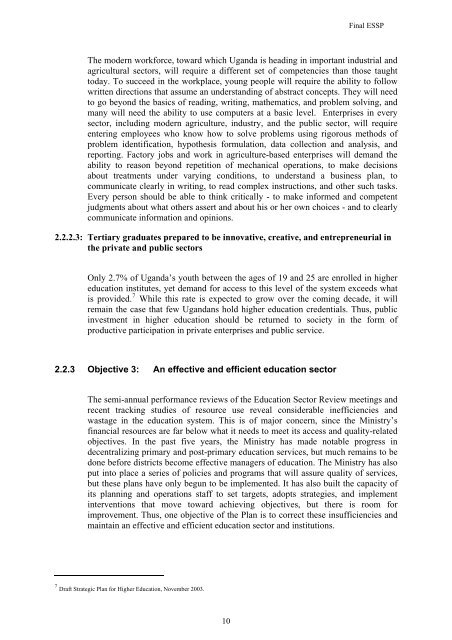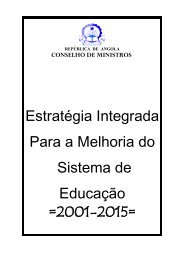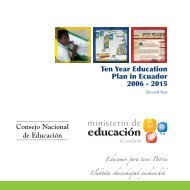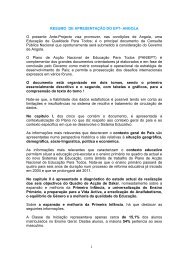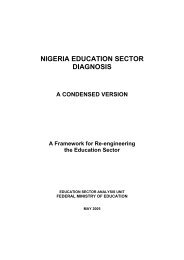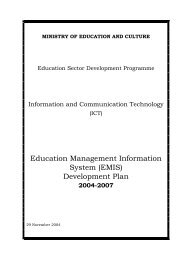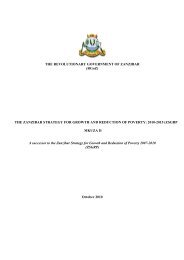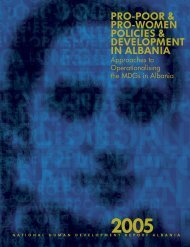Education Sector Strategic Plan 2004-2015 - Planipolis
Education Sector Strategic Plan 2004-2015 - Planipolis
Education Sector Strategic Plan 2004-2015 - Planipolis
Create successful ePaper yourself
Turn your PDF publications into a flip-book with our unique Google optimized e-Paper software.
Final ESSP<br />
The modern workforce, toward which Uganda is heading in important industrial and<br />
agricultural sectors, will require a different set of competencies than those taught<br />
today. To succeed in the workplace, young people will require the ability to follow<br />
written directions that assume an understanding of abstract concepts. They will need<br />
to go beyond the basics of reading, writing, mathematics, and problem solving, and<br />
many will need the ability to use computers at a basic level. Enterprises in every<br />
sector, including modern agriculture, industry, and the public sector, will require<br />
entering employees who know how to solve problems using rigorous methods of<br />
problem identification, hypothesis formulation, data collection and analysis, and<br />
reporting. Factory jobs and work in agriculture-based enterprises will demand the<br />
ability to reason beyond repetition of mechanical operations, to make decisions<br />
about treatments under varying conditions, to understand a business plan, to<br />
communicate clearly in writing, to read complex instructions, and other such tasks.<br />
Every person should be able to think critically - to make informed and competent<br />
judgments about what others assert and about his or her own choices - and to clearly<br />
communicate information and opinions.<br />
2.2.2.3: Tertiary graduates prepared to be innovative, creative, and entrepreneurial in<br />
the private and public sectors<br />
Only 2.7% of Uganda’s youth between the ages of 19 and 25 are enrolled in higher<br />
education institutes, yet demand for access to this level of the system exceeds what<br />
is provided. 7 While this rate is expected to grow over the coming decade, it will<br />
remain the case that few Ugandans hold higher education credentials. Thus, public<br />
investment in higher education should be returned to society in the form of<br />
productive participation in private enterprises and public service.<br />
2.2.3 Objective 3: An effective and efficient education sector<br />
The semi-annual performance reviews of the <strong>Education</strong> <strong>Sector</strong> Review meetings and<br />
recent tracking studies of resource use reveal considerable inefficiencies and<br />
wastage in the education system. This is of major concern, since the Ministry’s<br />
financial resources are far below what it needs to meet its access and quality-related<br />
objectives. In the past five years, the Ministry has made notable progress in<br />
decentralizing primary and post-primary education services, but much remains to be<br />
done before districts become effective managers of education. The Ministry has also<br />
put into place a series of policies and programs that will assure quality of services,<br />
but these plans have only begun to be implemented. It has also built the capacity of<br />
its planning and operations staff to set targets, adopts strategies, and implement<br />
interventions that move toward achieving objectives, but there is room for<br />
improvement. Thus, one objective of the <strong>Plan</strong> is to correct these insufficiencies and<br />
maintain an effective and efficient education sector and institutions.<br />
7 Draft <strong>Strategic</strong> <strong>Plan</strong> for Higher <strong>Education</strong>, November 2003.<br />
10


